
Eriocraniidae is a family of moths restricted to the Holarctic region, with six extant genera. These small, metallic moths are usually day-flying, emerging fairly early in the northern temperate spring. They have a proboscis with which they drink water or sap. The larvae are leaf miners on Fagales, principally the trees birch (Betula) and oak (Quercus), but a few on Salicales and Rosales.

Dyseriocrania subpurpurella is a diurnal moth from the family Eriocraniidae, found in most of Europe. The moth was first named by the English entomologist, Adrian Hardy Haworth in 1828.

Eriocrania semipurpurella is a moth of the family Eriocraniidae, found from Europe to Japan and in North America. It was first described by James Francis Stephens in 1835. The species closely resembles Eriocrania sangii and the larvae of both species mine the leaves of birch.
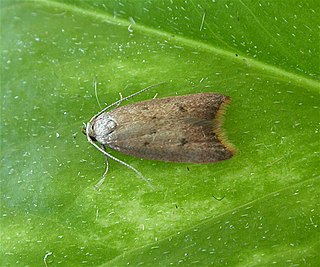
Tachystola acroxantha is a moth of the family Oecophoridae. It is native to Australia, but is an invasive species in New Zealand and Europe, probably imported with Australian plants.

Anacampsis populella is a moth of the family Gelechiidae, which is native to Europe and has been accidentally introduced to North America. It was first described in 1759 by Carl Alexander Clerck, a Swedish entomologist. The type specimen is from Sweden. The foodplants of the larvae are poplars and willows.

Micropterix mansuetella is a species of moth belonging to the family Micropterigidae and can be found in Europe, in very wet woodlands, fens and carrs. The imago was described by Philipp Christoph Zeller in 1844, but the larva and pupa are poorly described.

Eriocrania sangii, the large birch purple, is a moth of the family Eriocraniidae found in Europe and described by John Henry Wood in 1891. The moth can be found flying in sunshine around birch trees and the larvae feed on birch leaves.
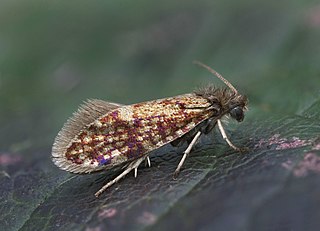
Eriocrania cicatricella is a moth of the family Eriocraniidae found in Europe. It was first described by Johan Wilhelm Zetterstedt in 1839. The larvae mine the leaves of birch.
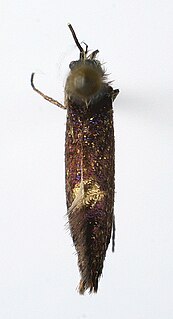
Eriocrania salopiella is a moth of the family Eriocraniidae and is found in Europe. It was described by the English entomologist, Henry Tibbats Stainton in 1854. The larvae mine the leaves of birch.

Eriocrania sparrmannella also known as the mottled purple is a moth of the family Eriocraniidae, found in Europe and Japan. It was first described by the French entomologist, Louis Augustin Guillaume Bosc in 1791. The specific name honours the Swedish naturalist Anders Erikson Sparrman. The larvae mine the leaves of birch.

Eriocrania unimaculella is a moth of the family Eriocraniidae found in Europe. It was first described by the Swedish naturalist Johan Wilhelm Zetterstedt in 1839. The larvae feed inside the leaves of birch, making a mine.

Eriocrania chrysolepidella is a moth of the family Eriocraniidae found in Europe. It was first described by the German entomologist, Philipp Christoph Zeller in 1851. The larvae mine the leaves of hazel and hornbeam.

Stigmella salicis is a moth of the family Nepticulidae which is found in Europe. It was first described by the English entomologist, Henry Stainton in 1854. The type locality is from England.

Stigmella obliquella is a moth of the family Nepticulidae which feeds on willow and can be found in Asia and Europe. It was first described by Hermann von Heinemann in 1862.

Ectoedemia intimella is a moth of the family Nepticulidae which is found in Europe. It flies in June and July and the larva mine the leaves of willows from July to November.
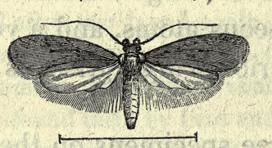
Agonopterix rotundella is a moth of the family Depressariidae and is found in most of Europe. It was first described from moths found in Surrey, England by the entomologist John Douglas in 1846.

Epermenia aequidentellus, also known as the carrot lance-wing, is a moth of the family Epermeniidae found in Europe, Madeira and the Canary Islands. It was first described by Ernest Hofmann in 1867, from a specimen found in Vorderer Kaiser, near Kufstein, Austria.
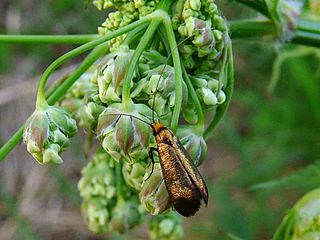
Adela cuprella is a moth of the family Adelidae and are found in most of Europe. It was first described by Michael Denis & Ignaz Schiffermüller in 1775 and the type locality is from Austria. They can be found flying around sallows (Salix) species during the day in April and May.

Psychoides verhuella is a moth of the family Tineidae found in Europe. It was first described in 1853, by Charles Théophile Bruand d'Uzelle from a specimen from Besançon, France. It is the type species of the genus Psychoides, also raised by Charles Bruand in 1853. The larvae feed on ferns.
Scythris siccella is a moth of the family Scythrididae first described by the German entomologist Philipp Christoph Zeller in 1839, found in Europe.
















